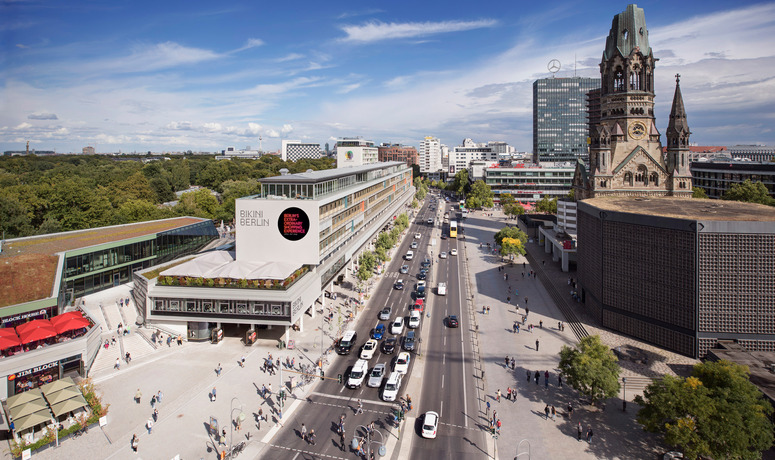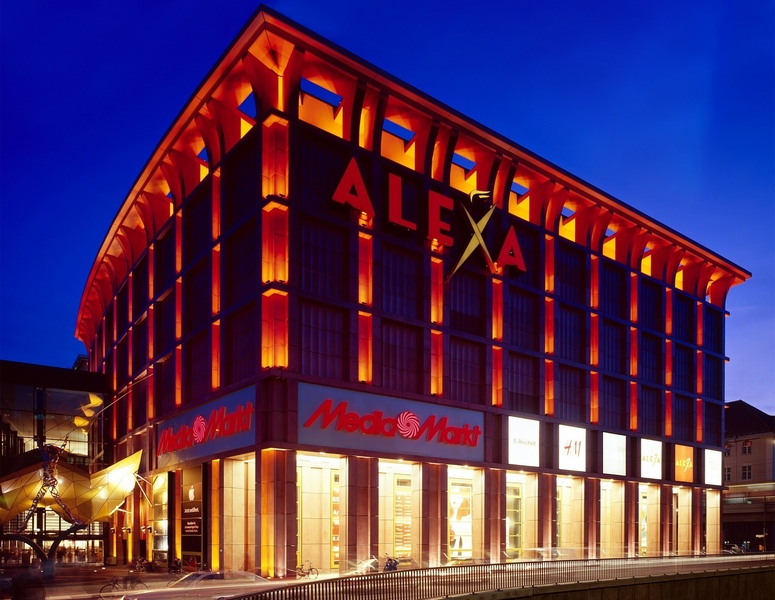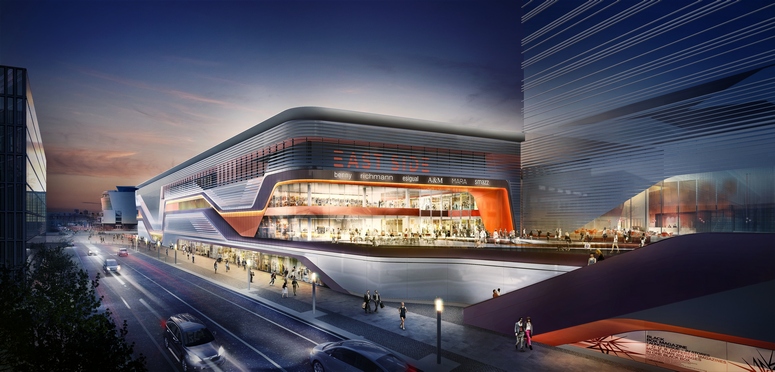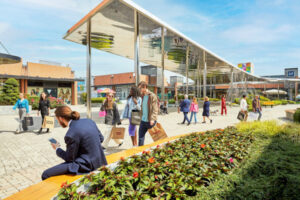Today, it’s at almost €60 billion, but it has at least been declining for some years now. The city has therefore not become richer. Even though Wowereit certainly wasn’t thinking of its shopping centers: What do retailers, project developers, and investors think of the city? Is Berlin still “sexy”?
By Udo Radtke

Let’s look at some facts: With 3.5 million inhabitants, Berlin is by far the largest city in Germany—and it’s growing. In 10 years, more than 3.8 million inhabitants will have their main residence in Berlin.
With a GfK retail purchasing power index level of 96.7, the city lies slightly below the German average, but Berlin’s overall annual demand potential is over €19 billion.
This enormous market volume certainly makes Berlin a highly interesting retail location. What’s more, it’s not just Berliners who shop in the city. After all, Berlin is the dominant center of the six-million-resident metropolitan region of Berlin-Brandenburg.
On top of that come the many tourists: With 12.7 million statistically recorded guests and 31 million overnight stays in 2016, Berlin is the leading destination for German urban tourism—even though it still lacks an international airport. This is why the city has a positive retail centrality of 106.1 despite strong competition from the surrounding area.
City with 67 shopping centers
Berlin is hip, “the place to be”: It’s a distinctive start-up scene, a media location, a fashion center, and an all-around urban trendsetter. A shopping city? Definitely. Ku’Damm and Tauentzien have been internationally oriented shopping areas since the 1950s.The historic KaDeWe is still the largest department store in continental Europe and the Europa Center, which was completed in 1965, was not only a landmark in the western part of the divided city, but also one of the first shopping centers anywhere in Germany.
Even during the GDR-era, Alexanderplatz, with its Centrum department store, was perhaps the most important shopping destination in East Germany. The Centrum that opened near the Ostbahnhof in 1979, then the most modern department store in the GDR, relied in part on shoppers from Poland, Czechoslovakia, and the Soviet Union. After German reunification, Berlin quickly became the capital of shopping centers. An overview published by IHK Berlin now lists 67 shopping centers in the city—and does not claim to be complete.
At first glance, the sheer number of shopping centers is impressive. By itself, would seem to suggest a very diverse scene. A closer look, however, quickly puts the number into perspective. IHK’s overview includes centers with just 5,000 sq m of space and thus also a multitude of completely unspectacular local supply and district centers.

According to an analysis by GfK Geomarketing from 2016, only 10 of the 67 shopping centers in Berlin can be said to have a high degree of fashion competence. Such competence tends to be critical for a shopping center’s long-range attractiveness. Since most of Berlin’s centers do not have a pronounced offer in the fashion sector, shopping centers do not play as important a role in the attractiveness of Berlin’s retail trade as their mere number would suggest.
For many locations in Berlin, however, malls are decisive for the composition, attractiveness, and appeal of the offer. The top location in this respect is Schloßstraße, with its four shopping centers Boulevard Berlin, “Das Schloss”, Forum Steglitz, and Schloßstraßencenter. Schloßstraße is traditionally the most important shopping destination for southwestern Berlin, primarily the Steglitz-Zehlendorf district, which is very rich in purchasing power.
Primark has an additional, regional appeal since it opened in 2012 in Schloßstraßencenter, which was specially remodeled to welcome the store. Even Boulevard Berlin, which was launched in the same year with great ambitions, has not been able to attract many tourists to Schloßstraße or to appeal to broad customer classes from other parts of the city, however.
Moreover, the magnetic effect that Primark has there will diminish as the Irish chain expands its store network. After the Primark at Alexanderplatz, a third Berlin store will be opening in a very prominent location at Zoologischer Garten station at the end of 2017 or beginning of 2018 and will certainly influence the catchment areas of the two existing branches.

Frequently only local customers
It thus remains somewhat sobering to realize that the mere accumulation of shopping centers is not a guarantee of being able to speak to customers outside a given neighborhood or to win shopping tourists.
These still tend to be oriented towards the classic shopping destinations. These remain the locations in the two areas around Kurfürstendamm and the Tauentzienstraße in the western half of the city and in the area between Potsdamer Platz and Alexanderplatz in the eastern half. They have an offer that appeals to locals and tourists alike. Despite overall strong and growing competition in Berlin’s retail market, these areas show solid development dynamics.
First to the West: KaDeWe is automatically associated with this part of the city. It remains an institution. This is only possible because the operator consistently pursues the ambition to be state-of-the-art and to invest in the property continuously. The Europa-Center has also continued to evolve and has above all opened to the outside. There are nevertheless no plans to take the big step of redesigning the now rather passé mall. The western city is the leading location for flagship stores in Berlin and has the most extensive range of luxury brands at the Ku’Damm locations.
Bayrische Hausbau implemented a courageous concept unique beyond Berlin when it converted the Bikini-Haus on Budapester Straße and opened the concept mall Bikini Berlin in 2014. The focus on concept stores and pop-up boxes remains consistent, even if this has not yet guaranteed that the center is fully let. Bikini Berlin will also be integrated better into the surrounding spatial structures and becomes more visible once the aforementioned Hines project Zoom at Bahnhof Zoo opens with the city’s third Primark store.
For many years, there was talk about revitalizing Kudamm Karree, but the plans always failed due to the real estate’s tricky structure, with two theaters and an atomic bomb shelter. It seems a solution has now been found in the form of demolition and new construction. Cells Bauwelt intends to begin the work in 2018. On the other hand, Signa’s plans to convert the Karstadt on Ku’Damm into a shopping center have been put on ice.

Exciting city areas
In the city’s east, the Alexa shopping center at Alexanderplatz is using the expiration of 10-year lease contracts for a bit of restructuring. The center has had to bear a fair amount of ridicule due to its appearance (“the pink bunker”), but it was accepted very quickly by locals and tourists alike and gave Alexanderplatz the fresh impetus for further development that it sorely needed at that time.
What’s more, competition from HGHI’s LP12 – Mall of Berlin on Leipziger Platz, one of Berlin’s top three centers, is hardly noticeable on Alexanderplatz. There were changes in occupancy levels in Potsdamer Platz Arkaden, close to the Mall of Berlin, however. Further business openings on Leipziger Platz (including Uniqlo), are raising the profile of the Potsdamer Platz/Leipziger Platz area. The area’s potential nevertheless seems to be exhausted for now. That’s why a 20,000-sq-m luxury wing expansion, which was announced at almost the same time the Mall of Berlin opened, has not yet been finalized.
The area around Hackescher Markt remains one of the trendiest elements in city’s east and enjoys great popularity among tourists. For international retailers wishing to expand to Germany, too, this area is near the top of the list of possible locations. One of the most interesting projects in Berlin is planned on the Tacheles site on Oranienburger Straße.
PWR Development is planning a diverse mix of uses, including apartments, retail, and gastronomy. The old buildings and ruins of the formerly anarchist cultural center will once again be used for artistic and cultural purposes. The project development is exciting because it will seek to answer the question of how to implement individual flair into a partially new structure that can keep up with those of the popular nearby Hackesche Höfe.

There are also exciting projects outside the city center. RFR and Freo are erecting the East Side Mall directly on Warschauer Straße in Friedrichshain, for instance.
This center is designed to meet the needs of the surrounding residential population in Friedrichshain’s hip neighborhoods, workers in the Mediaspree offices around the Mercedes-Benz Arena, and the tourists visiting the East Side Gallery and the nearby party district on the former RAW site.
They are striving for a diverse mix of local supply, fashion, and a large share of gastronomy within an architecturally sophisticated design. The proximity to Alexanderplatz and its comprehensive retail offerings is probably the biggest challenge.
Reconstruction of the Tegel Center
In addition to the Schultheissquartier in Moabit, which is more of a district center, HGHI is currently working on the reconstruction of the Tegel Center and parts of Gorkistraße, including the former Karstadt property, in Berlin Tegel.
The concept is innovative in Germany and offers the opportunity to bring the area, which was once an important retail location for Berlin’s Northwest, back to life. Karstadt at the Gorkistraße location, which was first shifted to Hertie in 2006 and then closed in 2009 more for strategic than business reasons, is already on board as a tenant.
There is activity at many other locations in Berlin as well. Its excellent and, with the population, growing market potential and tourism’s continuing growth spark the imaginations of project developers and retailers, while investors are always interested in good projects. Regarding the question at the beginning, we can thus state with confidence that “Berlin is sexy.”





